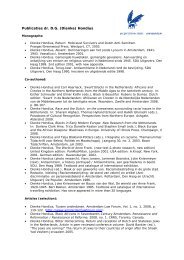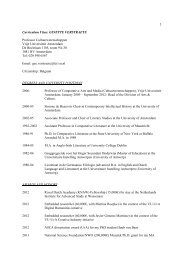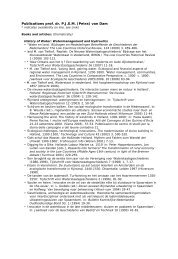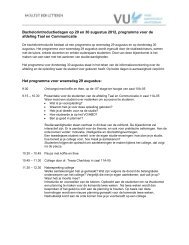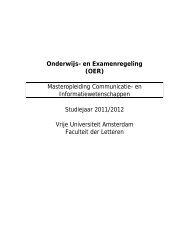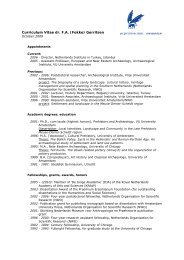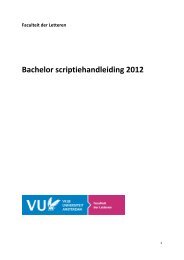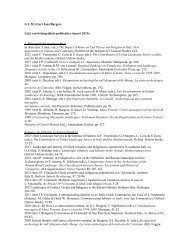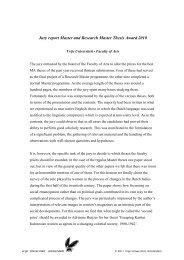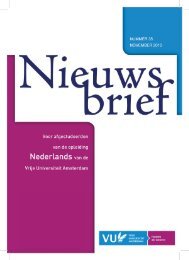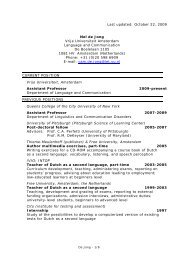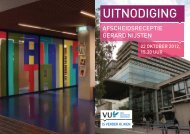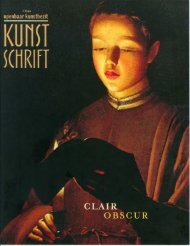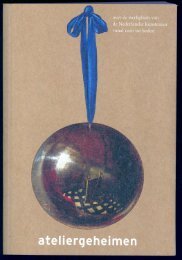Out of disegno invention is born” — Drawing a ...
Out of disegno invention is born” — Drawing a ...
Out of disegno invention is born” — Drawing a ...
You also want an ePaper? Increase the reach of your titles
YUMPU automatically turns print PDFs into web optimized ePapers that Google loves.
"<strong>Out</strong> <strong>of</strong> D<strong>is</strong>egno Invention <strong>is</strong> Born" - <strong>Drawing</strong> a Convinc-<br />
ing Figure in Rena<strong>is</strong>sance Italian Art,<br />
PAUL VAN DEN AKKER<br />
Vakgroep Kunstgeschieden<strong>is</strong><br />
De Boelelaan 1105<br />
1081 HV Amsterdam<br />
The Netherlands<br />
ABSTRACT: An important art<strong>is</strong>tic topic <strong>of</strong> Italian Rena<strong>is</strong>sance painting was the<br />
rendering <strong>of</strong> the human figure. As leading actors in a painted narrative, figures had to<br />
convince beholders <strong>of</strong> the reality <strong>of</strong> the matter depicted with appropriated attitudes and<br />
gestures. Th<strong>is</strong> article <strong>is</strong> about two ways <strong>of</strong> drawing or rather constructing the human<br />
figure art<strong>is</strong>ts developed to achieve th<strong>is</strong> goal. The first was only an adaptation to an old<br />
method: because <strong>of</strong> the rather simple and coarse elements used, constructions <strong>of</strong>ten<br />
resulted in faulty pictures and were for that matter <strong>of</strong>ten criticized. As th<strong>is</strong> article will<br />
show, the second method involved a new and very successful drawing skill, which not<br />
just required a different kind <strong>of</strong> knowledge <strong>of</strong> v<strong>is</strong>ual forms but <strong>of</strong> procedures <strong>of</strong> moving<br />
the hand, too.<br />
In Rena<strong>is</strong>sance Italy art<strong>is</strong>ts and theoreticians were concerned with the difficult<br />
but challenging question <strong>of</strong> how to render the human figure in a lifelike and<br />
convincing way. Figures played the leading roles in painted narratives. Their<br />
appearance, attitudes and gestures were meant to persuade the beholder <strong>of</strong> the<br />
reality <strong>of</strong> the matter depicted. How art<strong>is</strong>ts managed to do th<strong>is</strong> and particularly<br />
which skills they developed has rarely been the topic <strong>of</strong> serious art-h<strong>is</strong>torical<br />
inquiry. 2 The skill to which I am referring concerns the qualities which give the<br />
v<strong>is</strong>ual arts a h<strong>is</strong>tory <strong>of</strong> their own, d<strong>is</strong>tinct from, say, literature, philosophy or<br />
rhetoric. Painting <strong>is</strong> perhaps all too <strong>of</strong>ten compared to these non-v<strong>is</strong>ual arts at<br />
the expense <strong>of</strong> understanding what makes art v<strong>is</strong>ual.<br />
Of course there are similarities, such as the interest attached to <strong>invention</strong><br />
(invenzione). Alberti, for example, had stated in h<strong>is</strong> treat<strong>is</strong>e on painting, De<br />
Pictura <strong>of</strong> 1436, that for painters:<br />
it will be <strong>of</strong> advantage if they take pleasure in poets and orators, for these have many<br />
ornaments in common with the painter. Literary men, who are full <strong>of</strong> information<br />
about many subjects, will be <strong>of</strong> great ass<strong>is</strong>tance in preparing the composition <strong>of</strong> a<br />
'h<strong>is</strong>toria', and the great virtue <strong>of</strong> th<strong>is</strong> cons<strong>is</strong>ts primarily in its <strong>invention</strong>. Indeed,<br />
<strong>invention</strong> <strong>is</strong> such that even by itself and without pictorial representation it can give<br />
pleasure. 3<br />
More than a hundred years later, in the biography <strong>of</strong> a painter named Lippo in<br />
the 1568 edition <strong>of</strong> h<strong>is</strong> Lives, Vasari even termed <strong>invention</strong> "the truest mother <strong>of</strong><br />
architecture, painting and poetry, as well as <strong>of</strong> all the superior arts and <strong>of</strong> all the<br />
Argumentation 7: 45-66, 1993.<br />
© 1993 Kluwer Academic Publ<strong>is</strong>hers. Printed in the Netherlands.
46 PAUL VAN DEN AKKER<br />
marvels produced by man. ''4 But Vasari also realized that it takes two parents to<br />
produce children. In h<strong>is</strong> short treat<strong>is</strong>e on learning the art <strong>of</strong> drawing, he charac-<br />
terized <strong>d<strong>is</strong>egno</strong> (i.e. drawing), as others had already done, as "the father <strong>of</strong> our<br />
three arts, Architecture, Sculpture, and Painting". 5 Vasari defined <strong>d<strong>is</strong>egno</strong> as the<br />
reflection <strong>of</strong> a kind <strong>of</strong> knowledge (cognizione) or mental blueprint (concerto<br />
nell'animo) <strong>of</strong> the art<strong>is</strong>t. Th<strong>is</strong> knowledge relates to the v<strong>is</strong>ual forms <strong>of</strong> objects,<br />
especially <strong>of</strong> human figures, their parts and structure. After learning the body<br />
parts and their interrelationship, "attitudes in any position can be drawn by help<br />
<strong>of</strong> the imagination without one's having the living forms in view.". 6 And, Vasari<br />
continues, "out <strong>of</strong> th<strong>is</strong> <strong>invention</strong> <strong>is</strong> born" (e da c~o nasce l'invenzione), so he<br />
changed the metaphor unless he meant that father <strong>d<strong>is</strong>egno</strong> makes it possible for<br />
<strong>invention</strong> to bring forth her <strong>of</strong>fspring: "<strong>Out</strong> <strong>of</strong> th<strong>is</strong> <strong>invention</strong> <strong>is</strong> born, which<br />
groups figures in fours, sixes, tens, twenties, in such a manner as to represent<br />
battles and other great subjects <strong>of</strong> art.". 7<br />
While the term <strong>invention</strong> <strong>is</strong> shared with poets and orators, <strong>d<strong>is</strong>egno</strong> as a term<br />
originated in the province <strong>of</strong> the art<strong>is</strong>t. 8 Vasari was right, I think, in contending<br />
that the art<strong>is</strong>t's ability to invent narrative compositions depended mainly on h<strong>is</strong><br />
knowledge <strong>of</strong> drawing and <strong>of</strong> constructing the human figure. In th<strong>is</strong> article I will<br />
explain the new kind <strong>of</strong> <strong>d<strong>is</strong>egno</strong>, or method <strong>of</strong> drawing and <strong>of</strong> constructing the<br />
human figure, that was developed in Rena<strong>is</strong>sance Italy in order to fulfill the new<br />
task <strong>of</strong> persuading the viewer <strong>of</strong> the reality <strong>of</strong> the scene.<br />
Before going into th<strong>is</strong>, I would like first to briefly explain the method employed<br />
prior to the fifteenth century. Although our knowledge <strong>of</strong> it <strong>is</strong> limited by the<br />
scarcity <strong>of</strong> late medieval drawings, some idea can be formed through the<br />
analys<strong>is</strong> <strong>of</strong> fin<strong>is</strong>hed paintings. Take for example Duccio's Annunciation <strong>of</strong> the<br />
death <strong>of</strong> Mary, a panel that once was part <strong>of</strong> h<strong>is</strong> Maest?t, the great altarpiece he<br />
made for the High Altar <strong>of</strong> Siena Cathedral between 1309 and 1311 (Figure 1).<br />
The figures <strong>of</strong> Mary and Gabriel can be separated from the background and<br />
divided into several smaller elements (head-and-shoulder sections, hands, feet,<br />
fluttering drapery etc.). These components can then be reused to compose<br />
another scene. Simply by rearranging them slightly and adding a group <strong>of</strong><br />
figures, all set against the same background, the composition <strong>of</strong> The Apostles'<br />
farewell to the Virgin can be constructed. Only a few elements need be omitted<br />
or added to do th<strong>is</strong>; the form <strong>of</strong> each separate component <strong>is</strong> not altered to any<br />
great degree (Figure 2). Th<strong>is</strong> <strong>is</strong> what Duccio seems to have done in th<strong>is</strong> work<br />
(Figure 3), and a similar analys<strong>is</strong> could be made <strong>of</strong> other representations from<br />
the Maest?t. That art<strong>is</strong>ts really did think <strong>of</strong> figures as constructions <strong>of</strong> such rather<br />
fiat elements can be seen in a rare early fourteenth-century Florentine model<br />
drawing. In addition to whole figures the anonymous art<strong>is</strong>t also drew bits <strong>of</strong><br />
drapery and a head-and-shoulder section, probably to provide a repertory <strong>of</strong><br />
pictorial motifs on which he could draw in the future (Figure 4).<br />
Varying the attitudes <strong>of</strong> the figures was therefore primarily a matter <strong>of</strong><br />
rearranging the head, a bit <strong>of</strong> drapery, or the hands and feet. It was a sat<strong>is</strong>factory<br />
method as long as real<strong>is</strong>m was not yet the norm in the art <strong>of</strong> painting. But as I
OUT OF DISEGNO INVENTION IS BORN 47<br />
Fig. 1 Duccio, Annunciation <strong>of</strong> the death <strong>of</strong> Mary, panel, 1308-1311, Siena,<br />
Cathedral Museum.<br />
have already pointed out, from the beginning <strong>of</strong> the fifteenth century real<strong>is</strong>tic<br />
representation became a requ<strong>is</strong>ite. At first glance it looks very much as if<br />
drawing individual heads, feet, hands or draperies was still normal procedure for<br />
Rena<strong>is</strong>sance art<strong>is</strong>ts. Many preparatory studies <strong>of</strong> such elements have been<br />
preserved. Moreover, the publ<strong>is</strong>hed drawing manuals, which appeared from the<br />
sixteenth century onward, cons<strong>is</strong>ted <strong>of</strong> pages mainly filled with prints <strong>of</strong> such<br />
motifs. These books were in fact intended as primers for the abecedarian in<br />
drawing (Figure 5). 9 These first steps in the learning process are didactically<br />
v<strong>is</strong>ualized in one <strong>of</strong> Federico Zuccaro's (1540/41-1609) drawings from the<br />
beautiful series he dedicated to h<strong>is</strong> brother's training and career as an art<strong>is</strong>t<br />
(Figure 6). As the text on the step informs us, the young Taddeo (1529 -1566) <strong>is</strong><br />
found drawing by moonlight in a room in the house <strong>of</strong> Calavrese, h<strong>is</strong> first<br />
master. In h<strong>is</strong> notations in the margins <strong>of</strong> the 1568 edition <strong>of</strong> Vasari's Vite,<br />
Federico Zuccaro wrote about Taddeo:<br />
When he was living in the house <strong>of</strong> Calavrese he could never make drawings in the<br />
daytime and hardly ever in the evenings, and at night he had to go to bed in the dark<br />
because he was grudged even a drop <strong>of</strong> oil for a lamp; but h<strong>is</strong> desire was so great that<br />
he would get up and draw by moonlight on the shutters.", l°<br />
Federico's sheet illustrates the type <strong>of</strong> drawings he imagined would compr<strong>is</strong>e h<strong>is</strong>
48 PAUL VAN DEN AKKER<br />
Fig. 2. Alternative arrangement <strong>of</strong> elements <strong>of</strong> Fig. 1.<br />
brother's first efforts toward becoming a great painter: represented on the left<br />
shutter <strong>of</strong> the window are the elements <strong>of</strong> a figure drawing.<br />
Later on, but still following Rena<strong>is</strong>sance tradition, Giacomo Franco stated that<br />
learning the different components <strong>of</strong> the human figure <strong>is</strong> like learning the letters<br />
<strong>of</strong> the alphabet. In h<strong>is</strong> drawing manual De excellentia et nobilitate delineation<strong>is</strong><br />
libri duo from 1611 he directly likens h<strong>is</strong> teaching method to that <strong>of</strong> a writing<br />
master. 11 Just as a calligrapher would not teach h<strong>is</strong> pupils to write complete<br />
sentences at once, but rather first their letters, then syllables and finally words<br />
and sentences, Franco says that an art<strong>is</strong>t should not confront h<strong>is</strong> pupils im-<br />
mediately with the task <strong>of</strong> drawing a complete human figure, but rather should<br />
direct them to first attempt its individual parts. Th<strong>is</strong> compar<strong>is</strong>on between the two<br />
teaching methods - already made by Alberti in h<strong>is</strong> treat<strong>is</strong>e De Pictura <strong>of</strong> 1435 (I<br />
will return to th<strong>is</strong> later) - <strong>is</strong> indicative <strong>of</strong> the advantage <strong>of</strong> splitting up a figure<br />
drawing into subordinate elements. Only a very limited number <strong>of</strong> characters <strong>is</strong><br />
needed to form all conceivable words, which taxes our memory far less than<br />
having to learn a separate sign for each word. Every new word <strong>is</strong> composed <strong>of</strong><br />
familiar elements, even though one has never encountered it before. A similar<br />
advantage ought to hold for the above drawing method: the draftsman has only<br />
to master a comparatively small alphabet in order to invent countless new<br />
figures, or so it seems.<br />
Th<strong>is</strong> advantage did not only apply to the process <strong>of</strong> learning. As painters were
OUT OF DISEGNO INVENTION IS BORN 49<br />
Fig. 3. Duccio, The Apostles'farewell to the Virgin, panel, 1308-1311,<br />
Siena, Cathedral Museum.<br />
used to thinking in terms <strong>of</strong> elements, th<strong>is</strong> method was especially beneficial at<br />
the stage <strong>of</strong> dev<strong>is</strong>ing a convincing arrangement <strong>of</strong> figures. Lelio Orsi<br />
(1511-1587), for example, varied h<strong>is</strong> compositions both by transposing whole<br />
figures and by replacing certain components <strong>of</strong> them without changing others.<br />
Th<strong>is</strong> can be clearly seen in h<strong>is</strong> preparatory drawings for a Conversion <strong>of</strong> St.<br />
Paul. The study for the group <strong>of</strong> the fallen saint ra<strong>is</strong>ed from the ground by one<br />
<strong>of</strong> h<strong>is</strong> companions (Figure 7), for example, <strong>is</strong> a free copy in reverse after the<br />
group in Michelangelo's famous fresco in the Vatican. At the lower right Orsi<br />
drew another head for the figure <strong>of</strong> St. Paul, which when placed upon the trunk<br />
<strong>of</strong> the figure turns out to fit it perfectly. Probably Orsi was testing th<strong>is</strong> change in<br />
the position <strong>of</strong> the head because he wanted to clarify the relationship between St.<br />
Paul and the figure <strong>of</strong> God (who according to other preparatory drawings was to<br />
hover in the sky). A detail from one <strong>of</strong> the studies for the complete composition<br />
<strong>is</strong> illustrated here (Figure 8). In th<strong>is</strong> case even more elements <strong>of</strong> the figure have<br />
been modified, but again without effecting alterations to the rest. Orsi added an<br />
outstretched lower leg to the (unchanged) fight upper leg and replaced the right<br />
arm with a different one, which however was connected to the trunk at the same<br />
location.<br />
During the sixteenth century th<strong>is</strong> manner <strong>of</strong> constructing a figure was by no
50 PAUL VAN DEN AKKER<br />
Fig. 4. Anonymous Florentine, Model drawing (detail), second quarter <strong>of</strong> the 14th<br />
century, pencil, pen and ink, with traces <strong>of</strong> color, ca. 320 x 150 mm. (whole drawing),<br />
New York, Janos Scholz collection.<br />
ODOARDO FIALETTi<br />
• j,'.3~ )<br />
Fig. 5. Odoardo Fialetti, Torsos, print from Tutte le parti del corpo humano<br />
div<strong>is</strong>o in piu pezzi, 1608.
OUT OF DISEGNO INVENTION IS BORN 51<br />
Fig. 6. Federico Zuccaro, Taddeo Zuccaro drawing in the house <strong>of</strong> Calavrese, 1570s or<br />
1590s, black chalk, pen and ink with washes, 421 x 171 ram, private collection.
52 PAUL VAN DEN AKKER<br />
Fig. 7. Lelio Orsi, St. Paul Being Ra<strong>is</strong>ed from the Ground; in the lower right comer:<br />
St. Paul's head, 1560s, pen and ink, 156 x 194 ram., London, Brit<strong>is</strong>h Museum.<br />
means unusual. One <strong>is</strong> reminded <strong>of</strong> one <strong>of</strong> Armenini's 'true precepts', as he<br />
would call them himself, for making a picture. In h<strong>is</strong> treat<strong>is</strong>e on the art <strong>of</strong><br />
painting, De'veri precetti della pittura, which dates from 1587, Armenini<br />
describes approvingly how art<strong>is</strong>ts like Perino del Vaga (1500-1547) borrowed<br />
other art<strong>is</strong>ts' figures. From Perino' s drawings, many <strong>of</strong> which Armenini claimed<br />
to have seen, h<strong>is</strong> ability to borrow and transform figures into h<strong>is</strong> own <strong>invention</strong>s<br />
<strong>is</strong> evident. Armenini cites Perino del Vaga as a good example even for less<br />
inventive art<strong>is</strong>ts; as long as they complied with the rules, such a method <strong>of</strong><br />
borrowing was both perm<strong>is</strong>sible and helpful. Let me quote Armenini at length as<br />
regards these rules:<br />
Since, now, as many believe, it <strong>is</strong> impossible to create anything which has not already<br />
been found and made, it follows that one can and must use another's <strong>invention</strong>s,<br />
provided one takes care to adapt them with some changes and has the ability to make<br />
them appear as if born <strong>of</strong>, and created by, one's own mind. Th<strong>is</strong> may be done by<br />
making sure that other parts are different and conform to one's own style as best as<br />
one can, and with the intention <strong>of</strong> surpassing these borrowed <strong>invention</strong>s in quality and<br />
form, which can be achieved easily by many. The original form <strong>of</strong> any figure <strong>is</strong>
OUT OF DISEGNO INVENTION IS BORN 53<br />
Fig. 8. Lelio Orsi, The Conversion <strong>of</strong> St. Paul (detail), 1560s, pen and ink,<br />
457 x 301 mm., Oxford, Ashmolean Museum.<br />
altered greatly by a small change in any member, as by reversing members, changing<br />
the head slightly, ra<strong>is</strong>ing an arm, taking away a drape or adding drapes in another<br />
portion <strong>of</strong> the work or in presenting them differently, reversing the drawing or<br />
blurring it for the sake <strong>of</strong> expediency, or by imagining it in round relief. All these<br />
devices result in its no longer seeming the same figure. Consider well how and in how<br />
many ways such alterations can vary a single attitude <strong>of</strong> a single figure. And the<br />
change will be greater in the case <strong>of</strong> a composition with several figures. Therefore, we<br />
sanction th<strong>is</strong> practice as giving great aid and power to an art<strong>is</strong>t <strong>of</strong> weak intellectual<br />
capacity. But it <strong>is</strong> necessary that these changes be made in such a manner that the<br />
figures do not appear to be borrowed, and one must be careful to place them well in<br />
easy and natural attitudes and remember that the figures must gracefully and aptly<br />
complement each other. How all th<strong>is</strong> <strong>is</strong> to be done, we shall say elsewhere. Rarely <strong>is</strong> it<br />
a good pose when, for example, in a standing figure the fight leg juts out together with<br />
the right shoulder; it <strong>is</strong> much better perhaps if the right shoulder remains back and the<br />
left projects, with the head properly positioned. Certainly, nature clearly teaches us<br />
th<strong>is</strong> tw<strong>is</strong>ting and balancing, so that we see that grace and liveliness are to be given to<br />
all the limbs [...].12<br />
And yet, th<strong>is</strong> advice to vary the pose <strong>of</strong> a borrowed figure by moving, replacing<br />
or adding parts and at the same time retain the figure's easy and natural attitude<br />
was probably easier to give than to follow. Borrowing and transforming a figure<br />
was r<strong>is</strong>ky. If one takes seriously Giacomo Franco's compar<strong>is</strong>on <strong>of</strong> the<br />
draftsman's (or drawing pupil's) method with that <strong>of</strong> the calligrapher, one could<br />
still ra<strong>is</strong>e the objection that a letter <strong>is</strong> fiat, whereas a body part <strong>is</strong> not: a limb<br />
changes its v<strong>is</strong>ible form with every movement. Thus an art<strong>is</strong>t must in fact
54 PAULVAN DEN AKKER<br />
possess either a great stock <strong>of</strong> drawings or a very good memory if he <strong>is</strong> to<br />
successfully alter the attitude <strong>of</strong> a figure by changing one or two limbs and<br />
simultaneously preserve the rest <strong>of</strong> the image intact. After all, he had to d<strong>is</strong>cover<br />
exactly that form <strong>of</strong> a limb or body section which not only <strong>is</strong> persuasively<br />
natural<strong>is</strong>tic in itself, but which also connects to the rest <strong>of</strong> the body in an<br />
anatomically correct manner. In addition, he had to take care that h<strong>is</strong> figures<br />
complement one another in the composition as a whole, as Armenini rightly but<br />
perhaps all too casually remarked.<br />
The modern viewer may no longer be accustomed to criticizing old master<br />
paintings by these standards. Often he has been trained to evaluate them<br />
aesthetically, by looking at forms, colors or div<strong>is</strong>ions <strong>of</strong> surface as if dealing<br />
with abstract art avant la lettre. Upon v<strong>is</strong>iting many sixteenth-century Italian<br />
buildings decorated with frescoes d<strong>is</strong>playing lifesize figures however, even th<strong>is</strong><br />
modern viewer must admit that these figures <strong>of</strong>ten went wrong. That the<br />
problem was specifically one <strong>of</strong> construction <strong>is</strong> exemplified by the drawings <strong>of</strong><br />
Pomarancio (c. 1536-c. 1598). While the coherence between the legs and the<br />
upper body <strong>of</strong> one <strong>of</strong> h<strong>is</strong> soldiers (Figure 9) just falls within the realm <strong>of</strong><br />
acceptability, the junction <strong>of</strong> the same sections <strong>of</strong> another figure (Figure 10)<br />
leaves much to be desired. Each body part in itself was drawn well, but together<br />
they do not form a cohesive whole.<br />
Such m<strong>is</strong>takes did not go unnoticed during the Rena<strong>is</strong>sance. The painter<br />
Batt<strong>is</strong>ta Franco (1498-1561) for example was characterized by Vasari in h<strong>is</strong><br />
1568 biography as an art<strong>is</strong>t who knew perfectly well how to render individual<br />
limbs and other body parts, but not how to unite them to form a convincing<br />
figure. "One can thus conclude", so Vasari says:<br />
that those are in error who rely by working by that method on their ability to make a<br />
torso, an arm and a leg, or another member with exactly the right muscles, thinking<br />
that to understand those parts <strong>is</strong> everything. For it <strong>is</strong> a part and not the whole work.<br />
And he who after making the members well knows how to combine them together<br />
proportionately, <strong>is</strong> the one who <strong>is</strong> working perfectly and in a beautiful and good<br />
manner.". 13<br />
Thinking once again about Giacomo's compar<strong>is</strong>on between limbs and written<br />
characters, it <strong>is</strong> evident by now that the success <strong>of</strong> h<strong>is</strong> method could only be<br />
guaranteed if an art<strong>is</strong>t possessed an enormous repertory <strong>of</strong> drawings <strong>of</strong> limbs -<br />
either actual drawings or learned drawing routines. But in that case the ad-<br />
vantage <strong>of</strong> the method, that <strong>is</strong>, the wonderful compactness <strong>of</strong> the alphabet, <strong>is</strong> no<br />
longer applicable.<br />
Earlier, Leonardo da Vinci had stated that to him it seemed "impossible for<br />
any memory to retain all the aspects or changes <strong>of</strong> any member <strong>of</strong> any animal<br />
whatsoever.". 14 A hand, foot or an arm can have many appearances, or as he<br />
writes:<br />
The attitudes <strong>of</strong> the head and arms are infinite in number and so I shall not undertake<br />
to give any rule for them, but simply say that they should be easy and agreeable with<br />
different inclinations, and the joints that are there should be united intelligently, so<br />
that they will not seem to be pieces <strong>of</strong> wood.". 15
OUT OF DISEGNO INVENTION IS BORN 55<br />
Fig. 9.<br />
Th<strong>is</strong> method <strong>of</strong> constructing a figure from its parts was in fact, as I have already<br />
explained, a continuation <strong>of</strong> fourteenth-century practice. 16 One can compare th<strong>is</strong><br />
method to baking a cake from a commercial mix, which <strong>is</strong> only a matter <strong>of</strong><br />
mixing the contents <strong>of</strong> the prepared packets in the fight order. But if one were<br />
asked to bake cakes <strong>of</strong> varying flavors he would need more and more packets to<br />
sat<strong>is</strong>fy gourmet tastes. That <strong>is</strong> probably why there was an increase in model<br />
drawings and drawing manuals containing parts <strong>of</strong> figures. But th<strong>is</strong> was neither<br />
the most economical nor the most successful way <strong>of</strong> drawing figures. As every<br />
cook knows (or should know), if one wants to vary and refine d<strong>is</strong>hes one should<br />
use separate ingredients instead <strong>of</strong> ready-made packets. Th<strong>is</strong> same logic applies<br />
to rendering figures, and indeed, like good cooks, some art<strong>is</strong>ts and theoreticians<br />
seem to have realized th<strong>is</strong>. They drew attention to another way <strong>of</strong> constructing<br />
the human figure, namely employing much smaller ingredients than ready-made<br />
limbs. Th<strong>is</strong> was a completely new way <strong>of</strong> drawing, which facilitated the<br />
<strong>invention</strong> <strong>of</strong> figures in all conceivable attitudes and poses and made it possible<br />
to draw them from memory.
56 PAUL VAN DEN AKKER<br />
Fig. 9 + 10. Attributed to Pomarancio, Soldiers (details from preparatory drawings for<br />
unknown frescoes), second quarter <strong>of</strong> the 16th century, 269 x 162 mm., resp 248 x 171<br />
mm. (whole drawing), Oxford, Chr<strong>is</strong>t Church.<br />
Th<strong>is</strong> insight had its inception at the beginning <strong>of</strong> the fifteenth century. Alberti<br />
(c.1404-1472) was the first to point out that a figure was to be seen as composed<br />
<strong>of</strong> much smaller parts than the torso, head, arms and legs. He based h<strong>is</strong> opinion<br />
on a mathematical theory concerning human perception which he unfolds in the<br />
first book <strong>of</strong> h<strong>is</strong> little treat<strong>is</strong>e on painting, De Pictura. According to Alberti, in<br />
the real world three-dimensional forms are apprehensible to our eye as construc-<br />
tions <strong>of</strong> units and sub-units, each being v<strong>is</strong>ually perceptible as a unit because <strong>of</strong><br />
the relationship <strong>of</strong> the light beams it reflects. 17 Alberti describes the figure as a<br />
hierarchical construction (in decreasing magnitude) <strong>of</strong> limbs, surfaces, lines and<br />
dots. Alberti's theory <strong>is</strong> simple yet lucid and it concerns perception as well as<br />
drawing. 18 A painter who <strong>is</strong> familiar with mathematics <strong>is</strong> able to deceive the eye<br />
<strong>of</strong> the beholder by constructing an illusion with the aid <strong>of</strong> drawn dots, lines and<br />
surfaces: thin lines can be perceptually interpreted as the real outlines <strong>of</strong> a<br />
tangible form. 19<br />
From a number <strong>of</strong> fifteenth-century drawings we can tell that even before<br />
art<strong>is</strong>ts began to seriously study human anatomy, they must already have hit upon
OUT OF DISEGNO INVENTION IS BORN 57<br />
the idea <strong>of</strong> composing a figure from tiny movable sections as a better way <strong>of</strong><br />
creating lifelike and varied attitudes (Figure 11). When working by th<strong>is</strong> method,<br />
which I call the interrupted, or broken drawing method, the contour <strong>is</strong> divided<br />
into line segments. 2°<br />
Fig, 11. Antonio Rossellino or Desiderio da Settignano, Putti, second quarter <strong>of</strong> the 15th<br />
century, pen and ink, Florence, Uffizi.<br />
Although, compared to modern theories, Alberti's ideas on the perception <strong>of</strong><br />
form may not sound very soph<strong>is</strong>ticated, they are anything but naive. Experi-<br />
ments on the so-called 'saccadic eye movements' have shown that lines or<br />
contours do play an important part in our recognition <strong>of</strong> forms. These rapid<br />
unconscious eye movements allow the fovea to move across the v<strong>is</strong>ual field and<br />
fix the eye repeatedly on one point. These movements turn out to be directed<br />
primarily at the locations manifesting the strongest transitions in light intensity,<br />
that <strong>is</strong>, the outlines. 21<br />
Now an art<strong>is</strong>t whose aim it was to invent varied attitudes had to know all the<br />
units and sub-units, as well as the rules that govern their various arrangements.<br />
The problem was to find the right points where one line segment stops and a<br />
new one starts; in other words where the contour changes its direction. Th<strong>is</strong><br />
made art<strong>is</strong>ts search for a standard by which to assess the correct interrelation-<br />
ships and arrangements <strong>of</strong> these parts. From the last quarter <strong>of</strong> the fifteenth<br />
century onward they found it in the study <strong>of</strong> human anatomy.<br />
Again, modern research into v<strong>is</strong>ual perception affords us some insight into the<br />
practical usefulness <strong>of</strong> the study <strong>of</strong> anatomy. It seems that our eye movements
58 PAUL VAN DEN AKKER<br />
are attracted not only to contour lines but especially to the angles formed within<br />
them. In an easy but effective experiment the contours <strong>of</strong> a cat are selected<br />
wherever they meet to form a sharp angle. The selected thirty-eight angles are<br />
then transferred to a drawing and connected by straight lines, resulting in a<br />
recognizable picture. The two authors from whom I borrow th<strong>is</strong> example<br />
conclude "that angles and other informative details are the features selected by<br />
the brain for remembering and recognizing an object". 22 1 think th<strong>is</strong> conclusion<br />
<strong>is</strong> even more convincing if one does not draw the connecting lines but only the<br />
angles: particularly when you look at the paper while fluttering your eyelids you<br />
still recognize the drawing as a picture <strong>of</strong> a cat (Figure 12).<br />
J<br />
r%<br />
( J<br />
k.._ j<br />
Fig. 12. Picture <strong>of</strong> a cat. After Noton and Stark (see note 22).<br />
One could construct a recognizable picture <strong>of</strong> a human figure in a similar way.<br />
As an experiment I divided the contour <strong>of</strong> the Farnese Hercules, the famous<br />
classical sculpture, into line segments which indicate the changes in direction<br />
(Figure 13a). After th<strong>is</strong> I rearranged the points <strong>of</strong> intersection at which the<br />
angles were formed. Without having a real life model and, I must confess, with<br />
only a poor and very general knowledge <strong>of</strong> human anatomy, I here and there<br />
changed the length and the curvature <strong>of</strong> the lines between the points. Th<strong>is</strong><br />
resulted in a recognizable figure in another position (Figure 13b). Of course th<strong>is</strong><br />
drawing <strong>is</strong> aesthetically worthless. Nevertheless it makes manifest the advantage<br />
<strong>of</strong> th<strong>is</strong> new drawing method. What I have done <strong>is</strong> very much similar to the way<br />
Antonio Campi, for example, tried out two different poses in which to represent<br />
the fallen St. Paul (Figure 14). One only has to recall the 'ancient' method Orsi<br />
used (Figures 6 and 7) to recognize the difference.<br />
Thus the study <strong>of</strong> anatomy taught the art<strong>is</strong>t that the contours <strong>of</strong> a real body are<br />
determined by its muscles. When the muscles move, their relationship to one<br />
another <strong>is</strong> altered. Th<strong>is</strong> does not mean that at the stage <strong>of</strong> inventing or designing<br />
f
OUT OF DISEGNO INVENTION IS BORN 59<br />
f<br />
,/)z
60 PAUL VAN DEN AKKER<br />
Fig. 14. Antonio Carnpi, The Conversion <strong>of</strong> St. Paul, 1564, pen and ink, 144 x 181 mm.,<br />
Venice, Gallerie dell'Academia.<br />
a figure, art<strong>is</strong>ts always aspired to an anatomically accurate representation. The<br />
interrupted drawing method had rather a more structural or grammatical<br />
similarity to anatomy, as it was primarily concerned with the possibility <strong>of</strong><br />
varying the positions <strong>of</strong> the body. Th<strong>is</strong> <strong>is</strong> especially exemplified by the drawings<br />
<strong>of</strong> Raphael, for example, h<strong>is</strong> famous study <strong>of</strong> the Virgin and Child in the Brit<strong>is</strong>h<br />
Museum, and by the beautiful drawings <strong>of</strong> Tintoretto (Figure 15).<br />
Alberti stated that art<strong>is</strong>ts should learn figure drawing in the same manner as<br />
they did a style <strong>of</strong> handwriting. 23 I think Alberti was referring to italic script, a<br />
way <strong>of</strong> forming letters that was invented at the beginning <strong>of</strong> the fifteenth century<br />
and used by Alberti himself. In my opinion, Alberti was talking about a more<br />
basic connection between these two skills than Giacomo Franco did later.<br />
Thanks to modern research, we know a little bit about the complex mechan<strong>is</strong>ms<br />
<strong>of</strong> human motor development and hand-and-eye coordination. Combined with<br />
art-h<strong>is</strong>torical knowledge about the way Rena<strong>is</strong>sance art<strong>is</strong>ts were trained, th<strong>is</strong><br />
research elucidates to some extent the nature <strong>of</strong> the new skill at which Alberti in
OUT OF DISEGNO INVENTION IS BORN 61<br />
Fig. 15. Jacopo Tintoretto, Man with a child, black chalk, 334 x 225 mm., Rotterdam,<br />
Museum Boymans-van Beuningen.<br />
fact was already hinting. Of course he did not have the advantage <strong>of</strong> twentieth-<br />
century research, but one does not necessarily have to know exactly how a<br />
mechan<strong>is</strong>m works in order to explore its potential. 24<br />
The learning process for both italic script and figure drawing began in the<br />
fifteenth century with one line, meaning one movement. With practice art<strong>is</strong>ts<br />
and calligraphers were to learn how to make th<strong>is</strong> movement automatically and to<br />
use it as a bas<strong>is</strong> upon which to develop a complex skill. By first dividing an<br />
action into small increments we can learn how to make ever more complicated<br />
or composite movements that require little or no further mental effort. A penman<br />
learns to make letters and words automatically from essentially identical curves<br />
ordered in a specific way. 25 With practice the execution <strong>of</strong> movements can<br />
become a conditioned reflex; our 'mind' <strong>is</strong> thereby free to consider the follow-<br />
ing stages <strong>of</strong> the activity concerned before they are implemented. It <strong>is</strong> in the<br />
same manner, I believe, that a draftsman learns to form the contours <strong>of</strong> a figure<br />
by joining curved line segments. As I have demonstrated above, an art<strong>is</strong>t capable
62 PAUL VAN DEN AKKER<br />
<strong>of</strong> drawing the Farnese Hercules by heart would have memorized those points in<br />
the contour that mark the beginning and the end <strong>of</strong> the muscles. These are the<br />
locations he needs to remember: they function respectively as the points <strong>of</strong><br />
initiation and termination for the movement <strong>of</strong> h<strong>is</strong> hand. A drawing <strong>of</strong> a torso<br />
viewed from the back by Jacopo Zanguidi, called il Bertoja, for example, <strong>is</strong><br />
composed <strong>of</strong> separate and sometimes linked strokes <strong>of</strong> the pen (Figure 16).<br />
Fig. 16. Jacopo Zanguidi, called il Bertoia, Figure seen from the back (detail), pen and<br />
ink, 369 x 228 mm. (whole drawing), London, Brit<strong>is</strong>h Museum.<br />
Neither the exact speed nor the order <strong>of</strong> the movements can ever be<br />
reconstructed. But a close examination <strong>of</strong> the drawing creates the impression<br />
that the art<strong>is</strong>t very probably did not have to think consciously about every detail<br />
<strong>of</strong> every movement he made: in fact Jacopo Zanguidi thought only about where<br />
to begin and end h<strong>is</strong> elementary curves. The way the few lines which describe<br />
the right buttock are joined together without the pen ever having to leave the<br />
paper - very much like the fluent linking <strong>of</strong> letters in italic handwriting -<br />
suggests that these are the tracings <strong>of</strong> a few basic movements combined<br />
immediately by practice and routine into a specific order. Sketches like th<strong>is</strong> one<br />
therefore still reflect the learning process. During the course <strong>of</strong> the sixteenth<br />
century the calligraphic elegance which had originally been a side effect <strong>of</strong> th<strong>is</strong><br />
style <strong>of</strong> drawing became an aesthetic quality in its own right for which art<strong>is</strong>ts<br />
consciously strove (Figure 17). 26<br />
Just as in handwriting, lots <strong>of</strong> practice - which in th<strong>is</strong> case primarily involved
OUT OF DISEGNO INVENTION IS BORN 63<br />
Fig. 17. Anonymous, Figures, heads and limbs, pen and ink, 142 x 323 ram., Besan~on,<br />
Mus6e des Beaux-Arts et d'Arch6ologie.<br />
the study <strong>of</strong> human anatomy - could eventually give an art<strong>is</strong>t an entirely free<br />
hand to concentrate on the expressiveness <strong>of</strong> the figural pose instead <strong>of</strong> on the<br />
mechanics <strong>of</strong> h<strong>is</strong> own hand movements. As Vasari wrote in h<strong>is</strong> short treat<strong>is</strong>e on<br />
learning the art <strong>of</strong> drawing,<br />
the best thing <strong>is</strong> to draw men and women from the nude and thus fix in the memory by<br />
constant exerc<strong>is</strong>e the muscles <strong>of</strong> the torso, back, legs, arms, and knees, with the bones<br />
underneath. Then one may be sure that through much study attitudes in any position<br />
can be drawn by help <strong>of</strong> the imagination without one's having the living forms in<br />
view.". 27<br />
As I stated at the beginning <strong>of</strong> th<strong>is</strong> article, in Vasari's opinion, it was th<strong>is</strong><br />
pr<strong>of</strong>iciency that finally made it possible to invent a narrative containing groups<br />
<strong>of</strong> people.<br />
The advantage <strong>of</strong> the interrupted drawing method, like that <strong>of</strong> italic script,<br />
was and still <strong>is</strong> enormous: the more dextrous we become, the more freedom we<br />
have to direct our thoughts toward the content <strong>of</strong> the drawing or text. Yet<br />
learning to write script or make a drawing in th<strong>is</strong> manner was not a matter <strong>of</strong><br />
course but rather an extremely innovative development. Like italic script, the<br />
interrupted drawing method was a new and very succesful <strong>invention</strong> <strong>of</strong> the<br />
Rena<strong>is</strong>sance. It was however not employed by all art<strong>is</strong>ts. According to Ar-<br />
menini, whom I quoted above, many art<strong>is</strong>ts found learning th<strong>is</strong> method too time-<br />
consuming. Why not make use <strong>of</strong> ready-made, successful examples if these<br />
were readily available? The examples Armenini was thinking <strong>of</strong> were figures<br />
from classical statuary, after the works <strong>of</strong> Raphael (1483-1520), Michelangelo<br />
(1475-1564) and the now relatively lesser-known but once very famous<br />
Polidoro da Caravaggio (c.1499-1543). 28 On th<strong>is</strong> point he was diametrically<br />
opposed to Vincenzio Danti, author <strong>of</strong> another treat<strong>is</strong>e on the art <strong>of</strong> drawing<br />
which dates from 1567. Danti thought that only a thorough and extensive study<br />
<strong>of</strong> anatomy could insure reasonable pr<strong>of</strong>iciency in drawing. 29 Armenini,<br />
however, described a technique that was frequently employed alongside the
64 PAUL VAN DEN AKKER<br />
interrupted drawing method.<br />
In paintings we can see that Armenini's method was <strong>of</strong>ten used. The<br />
sixteenth-century viewer was however surely not expected to do so. In the<br />
quotation given above, Armenini adv<strong>is</strong>ed the painter to conceal h<strong>is</strong> technique,<br />
just as Vasari, in h<strong>is</strong> life <strong>of</strong> Batt<strong>is</strong>ta Franco, had done when he defined a good<br />
painting as one "in which the things borrowed from others" - that <strong>is</strong>, figures and<br />
body parts - "[were] so treated as not to be easily recognized.". 3°<br />
Perhaps Armenini was right when he said that th<strong>is</strong> method required less<br />
training and perhaps it was more efficient in most cases. In my opinion there<br />
must nevertheless have been another art<strong>is</strong>tic reason for the endurance <strong>of</strong> th<strong>is</strong><br />
method. Since the Rena<strong>is</strong>sance the ability to depict lifelike figures had become<br />
an important subject <strong>of</strong> art<strong>is</strong>tic competition. It therefore follows that painting<br />
more figures would have meant a greater demonstration <strong>of</strong> skill. In fact, a<br />
predilection for turning "compositions into veritable 'shop-windows' full <strong>of</strong><br />
figures", as Stumpel has stated, manifested itself during the sixteenth century. 3t<br />
Painters at that time were also required to d<strong>is</strong>play their skill in combining<br />
figures to create a persuasive narrative. But in th<strong>is</strong> regard the power to convince<br />
not only depended on the ability to render a pictorial illusion. Illusion <strong>is</strong> only<br />
one requ<strong>is</strong>ite <strong>of</strong> persuasiveness, a good design to guide the eye <strong>of</strong> the beholder<br />
on a fiat surface <strong>is</strong> another important element. The more figures there are, the<br />
more complicated <strong>is</strong> the task <strong>of</strong> making a good design (unless, <strong>of</strong> course, chaos<br />
<strong>is</strong> desired). The pers<strong>is</strong>tence <strong>of</strong> Armenini's method should perhaps be understood<br />
in th<strong>is</strong> context; while torsos, arms and legs are the units from which figures are<br />
constructed, they also turned out to be very useful as building blocks upon<br />
which to base the entire composition. I think that Smyth was correct when in h<strong>is</strong><br />
famous article he remarked that in Manner<strong>is</strong>t paintings, "the compositional units<br />
are the body's members". 32 He did not go into th<strong>is</strong> matter any further; I myself<br />
hope to adress it on another occasion.<br />
NOTES<br />
Th<strong>is</strong> article <strong>is</strong> a summary <strong>of</strong> the central thes<strong>is</strong> <strong>of</strong> my d<strong>is</strong>sertation Sporen van vaar-<br />
digheid. De ontwerpmethode voor de figuurhouding in de Italiaanse tekenkunst van de<br />
rena<strong>is</strong>sance, Abcoude 1991, which was publ<strong>is</strong>hed only in Dutch. I would like to thank<br />
A.Gasten for her help in translating the text <strong>of</strong> th<strong>is</strong> article.<br />
2 An important exception <strong>is</strong> <strong>of</strong> course the work <strong>of</strong> E. H. Gombrich, in particular h<strong>is</strong> book<br />
Art and illusion. A study in the paychology <strong>of</strong> pictorial representation, London 1960. See<br />
also J. Stumpel, The province <strong>of</strong> painting. Theories <strong>of</strong> Italian Rena<strong>is</strong>sance art, Utrecht<br />
1990.<br />
3 Translation taken from L. B. Alberti, On painting, trans. C. Grayson; introduction and<br />
notes by M. Kemp, London 1991, p. 88. For the Latin version, see L. B. Alberti, 'De<br />
Pictura', Opera volgari, vol. 3, ed. C. Grayson, Rome & Bari 1973, p. 93.<br />
4 Translation (slightly altered) taken from G. Vasari, The lives <strong>of</strong> the painters, sculptors<br />
and architects, vol. 1, trans. A. B. Hinds, ed. W. Gaunt, New York 1980, p. 186. For the<br />
Italian version, see G. Vasari, Levite de'piu ecceUenti pittori, scultori ed architettori, ed.<br />
G. Milanesi, 9 vols., Florence 1981 (facsimile <strong>of</strong> the 1906 edition), vol. 2, p. 11.
OUT OF DISEGNO INVENTION IS BORN 65<br />
5 G. Vasari, Vite, ibid., vol. 1, pp. 168-169.<br />
6 Translation taken from G. Vasari, Vasari on Technique, trans. L. S. Maclehose, New<br />
York 1960, p. 210. For the Italian version, see G. Vasari, Vite, op. cir. (note 4), vol. 1, pp.<br />
172-173.<br />
7 Ibid.<br />
8 It was especially F. Zuccaro who stated in h<strong>is</strong> L'ldea de'Pittori, ScuItori e Architetti<br />
from 1607 that for all human activities man needs a mental blueprint ('<strong>d<strong>is</strong>egno</strong> interno').<br />
On th<strong>is</strong> theory, see G. Kieft, 'Zuccari, Scaligero e Pan<strong>of</strong>sky', Mitteilungen des Kunsth<strong>is</strong>-<br />
tor<strong>is</strong>chen Institutes in Florenz 33 (1989) nr. 2-3, pp. 355-368.<br />
9 E.H. Gombrich, op. cir. (note 2), chap. 5; J. Bolten, Method and practice. Dutch and<br />
Flem<strong>is</strong>h drawing books 1600-1750, Landau 1985; H. Dickel, Deutsche Zeichenbiicher<br />
des Barock. Eine Studie zur Geschichte der KiinstIerausbildung, Hildesheim, Z~irich &<br />
New York 1987. For the Rena<strong>is</strong>sance tradition <strong>of</strong> drawing the classical torso, see P. van<br />
den Akker, op. cit. (note 1), chap. 8.<br />
10 Auct. cat. The life <strong>of</strong> Taddeo Zuccaro by Federico Zuccaro, from the collection <strong>of</strong> the<br />
Brit<strong>is</strong>h Rail Pension Fund, New York (Sotheby's), 11-1-1990, intr. and cat. entries by<br />
J.A. Gere, esp. cat. nr. 9. On the place th<strong>is</strong> drawing occupies within the series and the<br />
learning process it reflects, see also P. van den Akker, op. cit. (note 1), chap. 1.<br />
~1 D. Rosand, 'The Cr<strong>is</strong><strong>is</strong> <strong>of</strong> the Venetian Rena<strong>is</strong>sance Tradition', L'Arte 11 (1970) hr.<br />
12, pp. 5-53, esp. p. 13.<br />
12 Translation taken from G. B. Armenini, On the true precepts <strong>of</strong> the art <strong>of</strong> painting,<br />
trans, and ed. E. J. Olzewski, New York 1977, pp. 149-150. For the Italian version, see<br />
G. B. Armenini, De' veri precetti della pittura, libri tre, (facsimile <strong>of</strong> the 1587 edition),<br />
Hildesheim & New York 1971, p. 78.<br />
13 G. Vasari, Vite, op. cit (note 4), vol. 6, pp. 579-580.<br />
14 L. da Vinci, Treat<strong>is</strong>e on painting [Codex Urbinas Latinum 1270], 2 vols., trans, and<br />
annot. A. P. McMahon, intr. L. H. Heydenreich, Princeton 1956, vol. 1, p. 138 (par. 363);<br />
vol. 2, p. 130 recto.<br />
15 Ibid., vol. 1,145 (par. 382); vol.2, 114 recto.<br />
J6 There were <strong>of</strong> course important differences, for example that the parts now had to<br />
appear natural<strong>is</strong>tic and later on had to have the touch <strong>of</strong> classical art, and that a much<br />
larger repertoire <strong>of</strong> the various body parts was required. But the principle remained the<br />
same.<br />
17 L.B. Alberti, 'De Pictura', op. cit. (note 3), vol. 3, pp. 5-107 and pp. 299-340.<br />
18 Leonardo da Vinci later made similar statements, op. cit. (note 13), vol. 1, p. 4 (par. 3);<br />
vol. 2, p. 1 verso.<br />
19 L.B. Alberti, 'De Pictura', op. cit. (note 3), vol. 3, p.28.<br />
20 p. van den Akker, op. cit. (note 1), chaps. 4 and 6.<br />
21 See for example P. Morasso, 'Understanding cursive script as a trajectory formation<br />
paradigm', in Graphonomics. Advances in psychology. Contemporary research in<br />
handwriting, eds. H.S.R. Kao, G. van Galen, and R. Hoosain, Amsterdam 1986, pp.<br />
137-167.<br />
22 D. Noton and L. Stark, 'Eye Movements and V<strong>is</strong>ual Perception', Scientific American<br />
(june, 1971), pp. 34-43. See also I. Biederman, 'Recognition-by-components: a theory <strong>of</strong><br />
human image understanding', Psychological Review 94 (1987) nr. 2, pp. 115-147.<br />
23 L.B. Alberti, 'De Pictura', op. cir. (note 3), vol. 3, p. 94.<br />
24 See P. van den Akker, op. cit. (note 1), chaps. 5-7.<br />
25 j. Denier van der Gon, 'Spontaneity in Motor Expression and the Art <strong>of</strong> Playing the<br />
Spinal C(h)ord', in Authentication in the v<strong>is</strong>ual arts. A multi-d<strong>is</strong>ciplinary symposium,<br />
Amsterdam, 12th March ]977, eds. H.L.C. Jaffr, J. Storm van Leeuwen and L. H. van der<br />
Tweel, Amsterdam 1979, pp. 93-102; see also Kao et. al., op. cit. (note 20).<br />
26 See P. van den Akker, op. cit. (note 1), pp. 167-170.<br />
27 Translation taken from G. Vasari, Vasari on Technique, op. cit. (note 6), p. 210. For<br />
the Italian version, see G. Vasari, Vite (note 4), vol. 1, pp. 172-173.
66 PAUL VAN DEN AKKER<br />
28 Armenini, op. cit. (note 11), esp. chaps. 7 and 8.<br />
29 V. Danti, 'I1 primo libro del trattato delle perfette proporzioni di tutte le cose che<br />
imitare e ritrarre si possano con l'arte del <strong>d<strong>is</strong>egno</strong>', P. Barocchi, Trattati d'arte del<br />
cinquecent<strong>of</strong>ra manier<strong>is</strong>mo e controriforma, Bari 1960, vol. 1, pp. 207-269.<br />
30 G. Vasari, Vite, op. cit (note 4), vol. 6, p. 580. Translation taken from G. Vasari, The<br />
Lives, op. cit (note 4), vol. 4, p. 19.<br />
31 j. Stumpel, 'Speaking <strong>of</strong> Manner. Maniera and its meanings', op. cit (note 2), p. 125.<br />
32 C.H. Smyth, 'Manner<strong>is</strong>m and Maniera', in The Rena<strong>is</strong>sance and Manner<strong>is</strong>m. Studies<br />
in western Art: Acts <strong>of</strong> the twentieth international congress <strong>of</strong> the h<strong>is</strong>tory <strong>of</strong> Art, vol.2,<br />
Princeton, New Jersey, 1963, p. 183. Smyth, however, seems to face the question <strong>of</strong><br />
composition and style primarily as a perceptual one and not, as I believe Stumpel rightly<br />
claims (see note 2), as a problem <strong>of</strong> construction.



